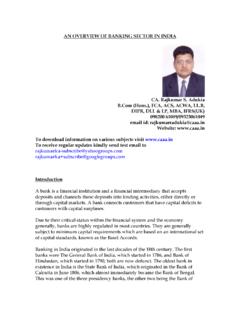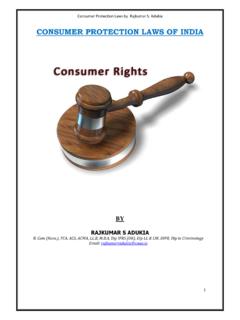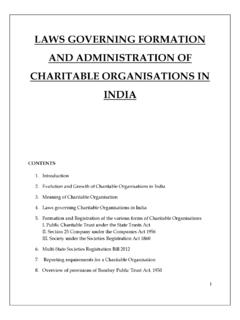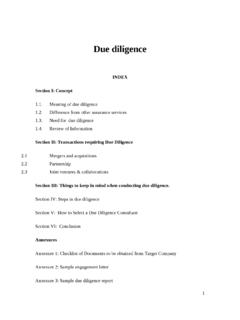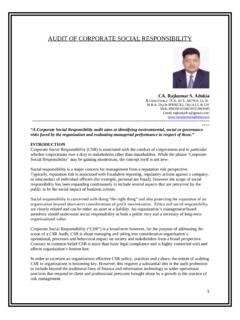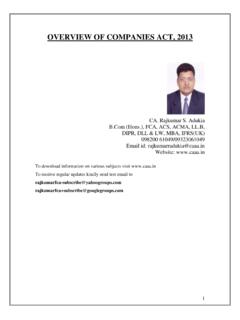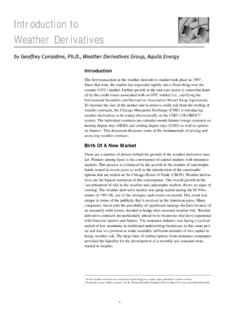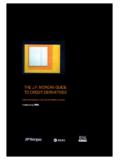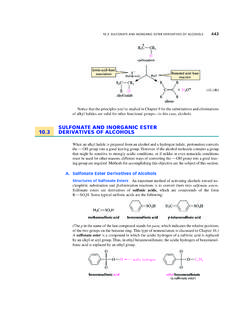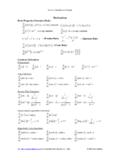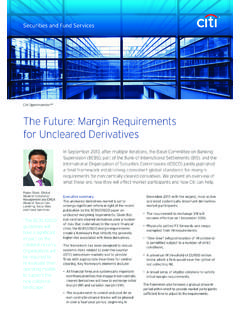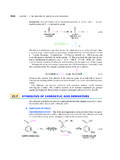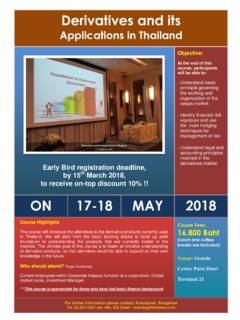Transcription of Concept of Derivatives - caaa.in
1 Concept of Derivatives 1. PREFACE. Derivatives have changed the world of finance as pervasively as the Internet has changed communications .Well they are everywhere nowadays. The most significant event in finance during the past decade has been the extraordinary development and expansion of financial Derivatives . These instruments enhance the ability to differentiate risk and allocate it to those investors who are most able and willing to take it -- a process that has undoubtedly improved national productivity, growth and standards of living. Derivatives products provide certain important economic benefits such as risk management or redistribution of risk away from risk-averse investors towards those more willing and able to bear risk.
2 Derivatives also help price discovery, the process of determining the price level for any asset based on supply and demand. All markets face various kinds of risks. This has induced the market par-ticipants to search for ways to manage risk. The Derivatives are one ofthe categories of risk management tools. As this consciousness about risk management capacity of Derivatives grew, the markets for Derivatives de-veloped. Derivatives markets generally are an integral part of capital markets in developed as well as in emerging market economies. These instruments assist business growth by disseminating effective price signals concerning exchange rates, indices and reference rates or other assets and thereby render both cash and Derivatives .
3 This book provides basics about Derivatives . What is Derivatives and different types of Derivatives ? How are they used? Index Topic 2. Introduction Derivatives Derivative Instruments A. Forward Contract B. Futures C. Options Put option Call Option D. Swap Interest Rate Swap Currency Rate Swap Strategies Using Derivatives Products A. Cap B. Floor C. Collars D. Vanilla E. Exotic F. Index Future Contract G. Index Option Contract H. Swaption I. Spread Bull Spread Bear Spread Butterfly spread Calendar spread Diagonal spread J. Straddle K. Strip and Strap L. LEPOS. Benefits of Trading In Derivatives How to Start Trading in Derivatives Trading and Settlement In Futures Contracts on index & individual securities Daily Mark-to-Market Settlement Final Settlement Trading and Settlement In Options Three types of Intermediaries in Stock Market A.
4 Trading Members B. Clearing members C. Trading cum Clearing Members Risk in Derivatives Brief Overview of Commodity Derivative 3. Annexure 1) Various stock futures available on BSE Stock exchange 2) Contract Specification for Stock Options contracts (Monthly & Weekly Options). 3) Contract Specification for Index Futures contracts 4) Contract Specifications for Single Stock futures 5) Screen Base Trading Terms 6) Glossary 7) Useful Websites INTRODUCTION. HISTORY OF Derivatives . The history of Derivatives is surprisingly longer than what most people think. Some texts even find the existence of the characteristics of derivative contracts in incidents of Mahabharata.
5 Traces of derivative contracts can even be found in incidents that date 4. back to the ages before Jesus Christ. However the commodities markets are one of the oldest prevailing markets in the human history. In fact Derivatives trading started off in commodities with the earliest records being traced back to the 17th century when Rice futures were traded in Japan. To start with probably the most significant as far as the history of futures markets, was the creation of the Chicago Board of Trade in 1848. In 1848, Chicago was developing as a major center for the storage, sale, and distribution of Midwestern grain, as it was the prime location on Lake Michigan.
6 Due to the seasonality of grain, Chicago's storage facilities were unable to accommodate the enormous increase in supply that occurred following the harvest. Similarly, its facilities were underutilized in the spring. Chicago spot prices rose and fell drastically. A group of grain traders created the "to-arrive" contract, which permitted farmers to lock in the price and deliver the grain later. This allowed the farmer to store the grain either on the farm or at a storage facility nearby and deliver it to Chicago months later. These to- arrive contracts proved useful as a device for hedging and speculating on price changes.
7 Farmers and traders soon realized that the sale and delivery of the grain itself was not nearly as important as the ability to transfer the price risk associated with the grain. The grain could always be sold and delivered anywhere else at any time. These contracts were eventually standardized around 1865, and in 1925 the first futures clearinghouse was formed. The Chicago Board of Trade (CBOT), the largest derivative exchange in the world, was established in 1848 where forward contracts on various commodities were standardized around 1865. From then on, futures contracts have remained more or less in the same form.
8 History of the Chicago Board of Trade 1848. On April 3, 1848, the Chicago Board of Trade (CBOT) was officially founded by 82. merchants at 101 South Water Street. Thomas Dyer was elected the first president of the CBOT. 1849-50. To arrive Contracts came into use for future delivery of flour, timothy seed and hay 1851. The earliest "forward" contract for 3,000 bushels of corn is recorded. Forward contracts gain popularity among merchants and processors. The Indian scenario 5. India has been trading Derivatives contracts in silver, gold, spices, coffee, cotton and oil etc for decades in the gray market.
9 Derivatives on stocks were traded in the form Teji and Mandi in unorganized markets The derivative market has existed in India since centuries as a result of the need for both users and producers of natural resources to hedge against price fluctuations in the underlying commodities. Although trading in agricultural and other commodities has been the driving force behind the development of Derivatives exchange in India, the demand for products on financial instruments-----such as currencies, stock indices have now far outstripped that for the commodities contract. Derivatives trading commenced in India in June 2000 after SEBI granted the final approval to this effect in May 2001.
10 SEBI permitted derivative segments of two stock exchanges, NSE and BSE, and their clearing house/corporations to commence trading and settlement in derivative contracts. SEBI approved trading in index futures contracts based on S&P CNX Nifty and BSE-30(Sensex) index. This was followed by approval for trading in options based on these two indexes and option on individual securities. In other words BSE created history on June 9, 2000 by launching the first Exchange traded Index Derivative Contract futures on the capital market benchmark index - the BSE. Sensex The first historical trade of 5 contracts of June series was done on June 9, 2000 at 9:55:03 between M/s Kaji & Maulik Securities Pvt.



